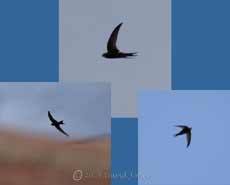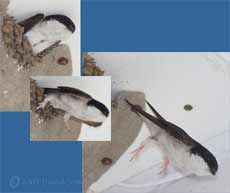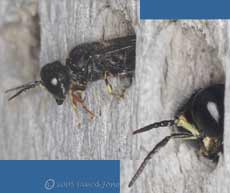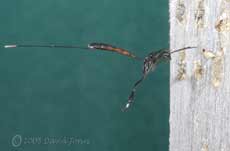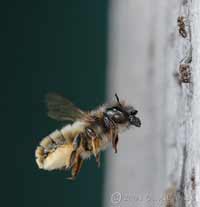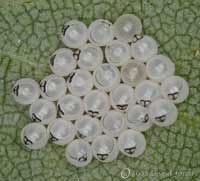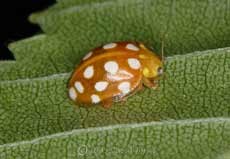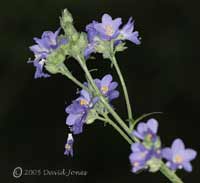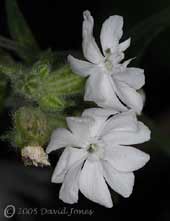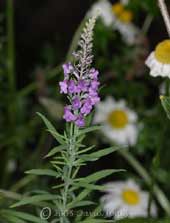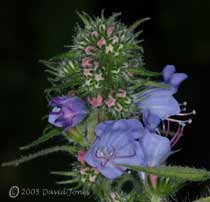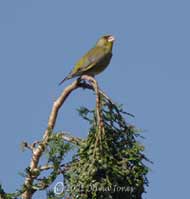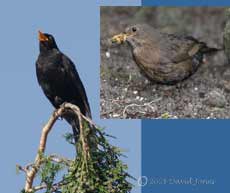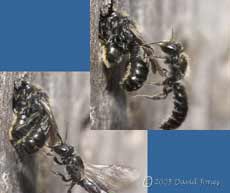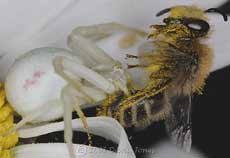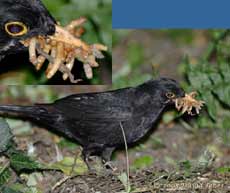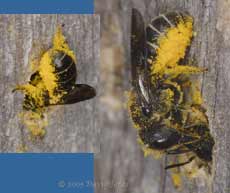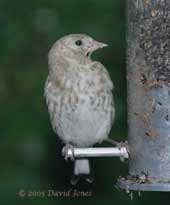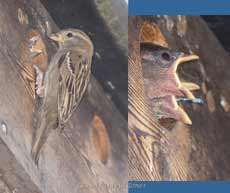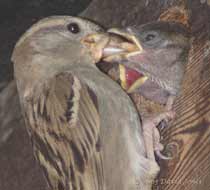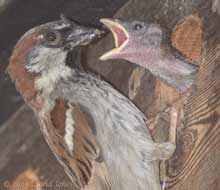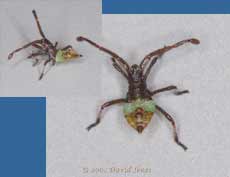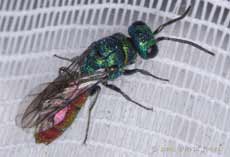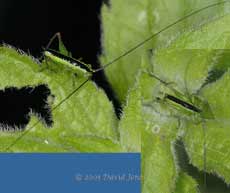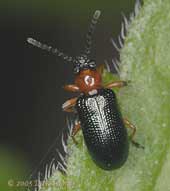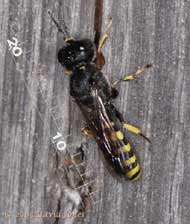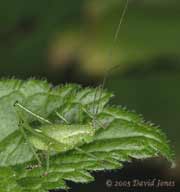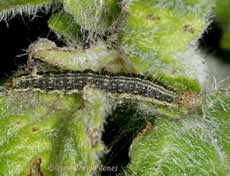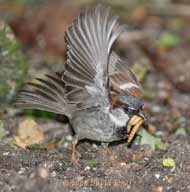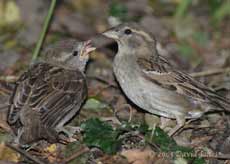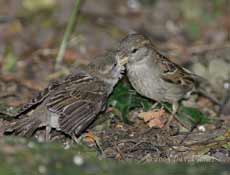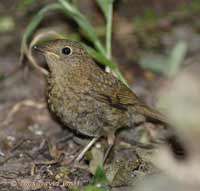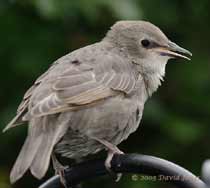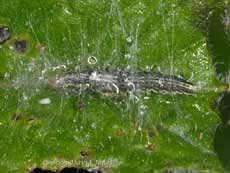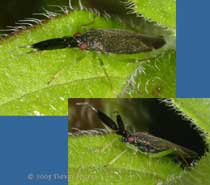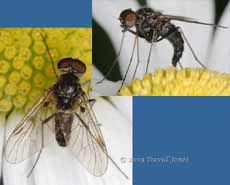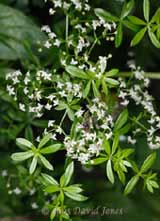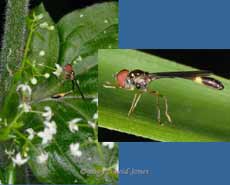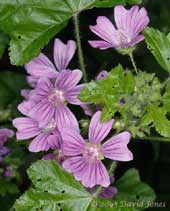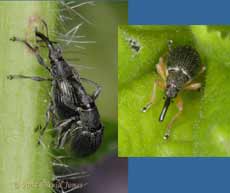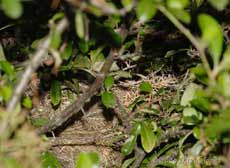Go to the last entry on this page .....Go to previous entry20 June - Another hot, dry day, with the temperature reaching 31C in the garden in the early afternoon (it is still 25C at 7.30pm). I have started taking precautions just in case a hosepipe ban is imposed in the near future - water from the shower is now partly diverted into a large container - That water will be used on the bamboo plants that are in containers. I am also looking at installing a diverter into the downpipe from the house guttering.
At least these three images show the
silhouette clearer than the previous images.
In comparison, the House martins in the centre and right hand boxes left the box and returned several times. This series of images of one of them as it launched itself into the air reminds me of the challenge that will be faced by the chicks when they eventually make their first flights.
Late this afternoon I spent a while watching activity at the bee hotel. The small bees photographed in my last entry were very active and they were joined by a slightly larger similar looking species that prefers the 3mm holes, although they also tried smaller ones. I hope to get some photographs of these tomorrow.
Back on 25 June last year I photographed a solitary wasp that had turned up at the 'hotel'. First thing this morning, at around 7.45am, I saw a couple of what appear to be the same species emerging for the first time. I managed to grab these two images, but failed to get a shot of the whole insect to help confirm that they are the offspring of last year's visitor.
A G.
jaculator appeared briefly again this afternoon. I managed to get one
photograph this time before it disappeared yet again.
At the moment, this is the only Osmia rufa Solitary bee active here at the moment, and she is having trouble with ants. For some reason the ants were targeting the hole she was working on and most times that she returned with bits of clay she had to deal with at least one in the hole (which is between the two ants).
A search of the branch and then a broader area of the tree revealed no nymphs. Neither did a search of the ground foliage below the branch. Where did they go? I know that Blue Tits and Sparrows visit the tree regularly, so they could have eaten them, but the leaf and eggs show no signs of damage caused by beaks.
The Orange Ladybirds are starting appear on the Birch. I could see just three today. This is roughly the same time that I saw them for the first time last year (excluding the fact that a couple appeared on the bamboos at the end of April).
On the plant front, there are a number of wild flowers to report on. First, tucked between the big pond and a Burberris bush and awkward to get to, is a group of Jacob's Ladder plants with their flowers in groups on tall stalks. They were already in flower when we came back from Cornwall but are rather hidden from sight and mind!
The wild flower seeds we planted in front of the workshop shed are providing us with interest, although the area has largely been taken over by the Oxeye Daisies at the moment and you have to look between their stems to find the hidden treasures. First of all, the White Campions are at their best in the evening as other plants close up their flowers. I have mentioned them before, but at the moment there are several plants in flower compared with just the one last year, so hopefully they will self-seed and produce even more in 2006.
The next plant and seen for the first time today, is a what seems to be solitary Toadflax.
And the final plant, also first seen today, is a single example of a Viper's Bugloss (Echium vulgare).
21 June - The summer Solstice (the longest day of the year) - it has been sunny and very warm, although at 27C in the garden it has been much more comfortable than the last few days. However, the forecast is for the temperature to head for 30C again over the next two days - Cornwall is cooler!!
The morning brought a welcome variation in the bird song at the bottom of the garden in the form of this Greenfinch which sang for quite a while from the highest conifer beyond the fence. I occasionally hear these but on catch brief glimpses these days, so this was a pleasure to watch and listen.
A short while later the Greenfinch was replaced by our regular vocalist, the male Blackbird, and at the moment he has good reason to sing. I forgot to write about it, but last Friday afternoon (17 June) there was an almighty crashing and banging, coming from the loudspeaker that broadcasts the sounds picked up by the Robin box microphone. I rushed down the garden just in time to see some dark grey, downy feathers fluttering down the far side of the Ivy tree. Whatever had attacked had disappeared, but these were obviously Blackbird feathers.
The male was giving his panic calls, and I feared the worst. However, a few minutes later I heard the quiet, almost hooting call of the female (I'm sure that is a completely wrong description), hiding in the conifers. I had seen little of the female since our return from holiday and I have wondered whether she had been trying to start another brood. Then, yesterday two events made things clearer. First of all, both birds came down to collect mealworms from under the Hawthorn, something they have down several times again today. Also, I spent a short time sitting down the West Wing yesterday afternoon and was surprised to see the pair going into the Ivy tree again, this time much deeper into the centre than previously. It seems that there are young hidden in there. This must be their seventh attempt this year, and it seems last week's attack failed to wreck this one. Hopefully we may see a successful conclusion this time. This afternoon I spent just a short time watching the bees again. The Osmia bee continues to work in the same hole, unbothered by ants while I watched, and I didn't see any of the solitary wasps today, but the tiny bees were very active. There is quite a swarm of them around the hotel while the sun shines on it, although by as soon as it is in shade in the late afternoon just about all activity stops very quickly.
They stayed in this position for over 30 minutes while the swarm continued to fly very close by. Every so often another male would suddenly fly up to the pair and 'bump' the male, although they never actually landed. I assume they were trying to cause it to release its grip on the female so that they could replace it - none succeeded.
23 June - The hot weather has continued over the last two days, with today being very humid and uncomfortable. I have done very little in the garden and the pond and plants behind it are still awaiting my attention from before our holiday. I had hoped to get my pond diary updated this week, but it looks as though that will have to wait until the weekend, or next week. In the meantime I need to record that we have two Reedmace flowerheads now. They were 'unveiled' over the last three days and today have started shedding pollen. I notice that this happened five days earlier last year, on the 18th June. There are still some Flag Iris flowers opening, and some Rhadinocerea micans larvae(a sawfly specific to the Flag Iris) are now munching on its leaves. The activity at the front of the house suggests that we are still waiting for eggs to hatch in the House Martin and Swift nests.
I check the Oxeye Daisies quite often each day, and there are two larger and two very small examples of these spiders. However, this is the first time I have seen one with something it has caught this year. It had already killed the bee and was busy feeding.
Yesterday, while I was out, Sheila was lucky enough to see a Red Admiral butterfly, and more unusually, a Banded Agrion Damselfly which landed very close to her. That is an insect I have never seen here. This afternoon I started taking a set of pictures of Liverwort plants that I have obtained from a local garden centre and plant nursery. I will probably add them to the pond diary once I get around to getting that up to date. The forecast for tomorrow indicates that
real possibility of rain, with possible thunderstorms. Temperatures may be
over 10C cooler by the next day. June 26 - The last few days have been a bit of a mixture. The thunder storms arrived as promised on the 24th and we had heavy rain, although not as heavy or prolonged as I had expected. The temperature dropped to around 18C and stayed that way yesterday (which was dry). Today it started cloudy but afternoon sunshine pushed the temperature up into the 20's again. I spent some of today doing some pruning around the garden, especially the plants on the far side of the big pond. I have also started clipping the new growth on the Hawthorn, a job I hope to complete during the week. As a result there hasn't been much time spent with the camera in the garden over the last few days (although I have been taking numerous liverwort pictures which may appear in the diary during the next week.
Here, the male is doing a puffin impersonation as he collects (I think) some 16 or 17 mealworms. There is a family of Magpies with a couple of youngsters about so I'm on alert for the sound of their calls anywhere near the garden at the moment. Other bird activity continues to be quiet. The few House Sparrows that come to feed spend more time competing with the Blackbirds for the mealworms for their young, although they only take away one at a time. We are seeing very little of the Martins at the moment - it's a matter of waiting until eggs hatch before things get exciting at the front of the house. This morning a Great Tit appeared under the Hawthorn to pick up some bits of chopped peanut. Despite nesting here last year this is a very unusual visitor this year. Also down after the peanut bits was a juvenile Dunnock. The couple of cooler days has meant that the bee hotel has been very quiet with the occupants staying 'indoors', but today's sunshine brought them out for a while during the afternoon.
They it slowly reversed out of the hole and it was then I saw a second bee's head appear in the entrance. Moments after the picture was taken, the pollen covered bee left and the other one retreated back out of sight.
27 June - Another warm, sunny day. I had intended to do a bit more gardening but yesterday's efforts required a 'day off' today!
The adult Goldfinches continue to visit the thistle feeders, but this morning a juvenile turned up. I managed to sneak this picture through a half open kitchen door, but it left before I could get into a better position. The adults returned several times during the day, but I didn't see the juvenile again.
I know that the chicks are fed insects (including mealworms) but I was surprised to see that a chick had just received damselfly, possibly a Common Blue male. You can see its abdomen poking out of the chicks mouth as it begs for more!
I watched for a while after that but there were no more damselflies, but a constant supply of larvae ( there were no mealworms available during this period). I caught a glimpse of a third beak, although I didn't capture it 'on film'. Here, mum pushes a larva into the chick's throat.
The male seemed less sure about the feeding business, tending to keep back as the chicks thrust out their open beaks. On a number of visits, he would turn up with food and perch on the guttering until his partner had returned with a feed. He would then wait until she had left the box before delivering his offering.
While I had the camera on the tripod to take the last two Sparrow pictures, this little character walked over the top of the lens. It's nymph of some sort, although I haven't any idea of what insect.
Back in the house I noticed a small insect on a net window curtain. Against the light from outside it just looked like a solitary bee - until the camera flash revealed its true colours. I think it is a Chrysis ignita, although I can't tell what sex. I was going to release it outside but it flew off and disappeared. I shall check the inside of the windows again tomorrow morning.
28 June - A very warm, breezy, dry but humid and day until a thunderstorm passed through in the evening. Another weary day, not helped by some noisy foxes(?) during the night, making very painful noises in our garden. Unfortunately, by the time I found a torch to look out they had headed off elsewhere. This morning the only signs of their presence were a couple of plants trampled next to the big pond. A morning trip to the dentist to start sorting out the tooth problem that nearly wrecked our last trip to Cornwall was a good excuse to put my feet up for a while. The Blackbirds and Sparrows continue to feed their young (the mealworm supply has run out, but the post should deliver more tomorrow). First thing this morning we had four adult and two very young Goldfinches at the feeders. Later an immature, but older individual with some adult feathers appeared. I wonder if the youngsters are a second brood, or just the offspring of a different pair. Whichever they are, their appearance is an encouraging sight.
Just 5mm long, it stood out because of the broad black band down its back. I assume that it is a nymph as I can't see any wings. The nearest match I can find is a Long-winged Conehead (Conocephalus discolor) which has a dark dorsal band, except in that case it is red on an adult.
Another leaf on the same plant acted as a temporary perch for this small beetle, some 4mm long. Although the elytra appears black in the photograph I think there was actually a hint of green about it. Its identity is a mystery as I can't match it to any of the beetles in my guides. Philippe Moniotte who takes insect photographs in Belgium suggests that it looks like Oulema melanopus.
Finally, on my way past the bee hotel, which was very quiet at the time, there was this (I think) solitary wasp measuring about 15mm in length and with bold yellow bands on the abdomen. It's another mystery that needs more investigation to get an ID. - Phillippe thinks it is certainly an Ectemnius species, possibly E. sexcinctus which 'digs in rotting wood for nest building and stock the nest with true flies'.
29 June - Except for a few drops of rain in the evening it has bee a dry, warm day. The morning's post brought our new mealworm supplies and a copy of a French magazine 'Insectes' in which one of my photographs has been published at the beginning of an article about solitary bees. My French is very poor so I have a bit of a translation challenge over the next few days! Following on from yesterday's photograph of the cricket, it wasn't seen today, but I did find the Speckled Bush Cricket that lives on the Geraniums. (Thanks to Tim Norriss for confirming the IDs of both crickets) This one is now just over 8mm in length. Over the last few weeks I have only been able to see one example, always in the same small area so I suspect that the pictures I have taken over that time may be of the same individual.
Several of the water mint plants have distorted tops where an insect has used silk to pull leaves together to form shelters. Today I spotted caterpillars like this one on two of these plants.
Our Blackbirds and Sparrows were soon taking away some of the fresh mealworms. Here, a male takes a beakful for the chicks in our nestbox.
This afternoon brought the sight of a Sparrow fledgling following its parent and begging for food.
It wasn't long before mum took the hint and fed the youngster.
A young Dunnock made a couple of nervous appearances under the Hawthorn today and so did this fledgling Robin. Since our return from Cornwall, adult Robins and Dunnocks have been only a rare sight here, and there was no sign of an adult while this youngster was here.
Early this evening we had the sight of a Goldfinch fledgling perched on the thistle feeder holder, and begging for food as a parent fed just below it. Unfortunately we didn't get to see it being fed because an adult Starling decided to land next to the youngster and scare it off. With that Starling was yet another fledgling following its parent everywhere and making a lot of noise as it did so.
30 June - The first time for ages that we have woken up to the sound of rain in the morning, and it has remained cloudy, with showers throughout the day.
This first picture is another of the caterpillar shown yesterday. This time it is sheltering from the rain under a 'Gazebo' of silk threads.
There is still no sign of the Cone-head Cricket on the mint plants, but I did spot this small bug with outsized antennae. I believe that it is Heterotoma merioptera which is predatory on aphids, but also feeds on buds and developing fruits on some plants.
The only insect spotted on the daisies this morning was this (I think) Chrysophilus cristatus a snipe-fly that prefers damp or shady places. I have seen several over the last few days but haven't got close enough for a photograph until now.
The Oxeye Daisies are coming to an end now, but the wild flower patch in front of the shed is throwing up a couple of more species. First of all, there are a couple of these Bedstraw plants ( probably Galium mollugo - the Hedge Bedstraw) which have been appearing over the last week.
As I took a couple of photographs of the plant a solitary hoverfly turned up to feed on them. It is Baccha elongata, a species I rarely see in the garden.
The other plant to record as appearing during the last week is this Common Mallow (Malva sylvestris).
A closer look was rewarded when I found two different species of weevil (which I can't identify). The right-hand individual was right at the top of the plant. The left-hand pair were mating on the plant's stem. The female appears to be feeding. Did she cause the damage to the stem?
On the bird front, some interesting items to note, and a puzzle! First of all, while I was having my morning cup of tea on the veranda at around 7.30am a Song Thrush turned up for the first time in a couple of months. After yesterday's comment about not seeing adult Robins one turned up soon after the Thrush, but I didn't see the juvenile all day (nor did I see a Dunnock). This morning the usual customers turned up to collect mealworms for their offspring. The Sparrows, a Starling, and both Blackbirds. Late this afternoon, Sheila and I were sitting on the veranda again, and I was throwing mealworms to the frogs that have gathered around the feeding area. It was amusing to watch the Sparrows as they nervously collected mealworms near to the frogs. It's also interesting to watch the interactions between the Sparrows and the Blackbirds. While the Sparrows are wary of the male Blackbird, the situation is reversed when the female comes down to feed. She seems easily intimidated by the Sparrows, and yet she holds her own against a Starling.
I had to look again in some disbelief - she is nest building again, no more than about 5ft from the veranda. When she sits on the nest, she and I can look at each other while I sit in my usual spot! Hopefully it will be well protected by the plant's vicious thorns. Just to add confusion, when she had a break from the task she joined her partner to take mealworms away for their other offspring - is there one or more fledglings hidden somewhere around us? Tonight the nest is only partially built, so I'm looking forward to seeing what happens tomorrow morning. Click on the images to see larger versions |
|
